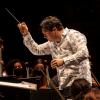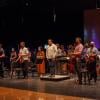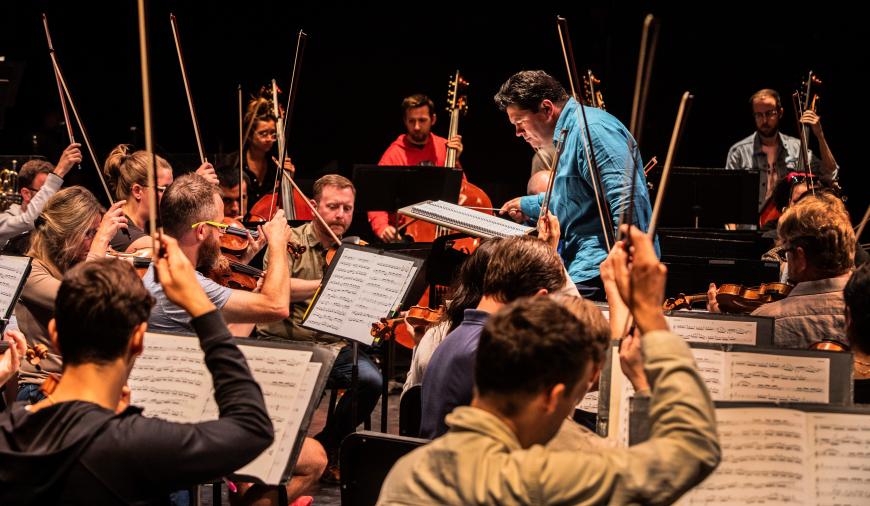
Would this be the year when the Cabrillo Festival of Contemporary Music, that fearless laboratory and staging ground for new orchestral works, finally wrestled the COVID pandemic to the ground?
2020 was a virtual season, as was 2021, with all of the offerings online only. Everything looked A-OK in 2022 for the first weekend, but an outbreak of COVID in the wind and brass sections led the festival to reconfigure the entire second weekend’s programs on the fly for just strings and percussion. No one said recovery would be easy.
Things looked business as usual for the first weekend of the 2023 festival, which kicked off Friday, Aug. 4 at the historic, if creaky, 83-year-old Santa Cruz Civic Auditorium. The portable tables and chairs for the opening-night dinner were waiting on a closed-off Church Street.
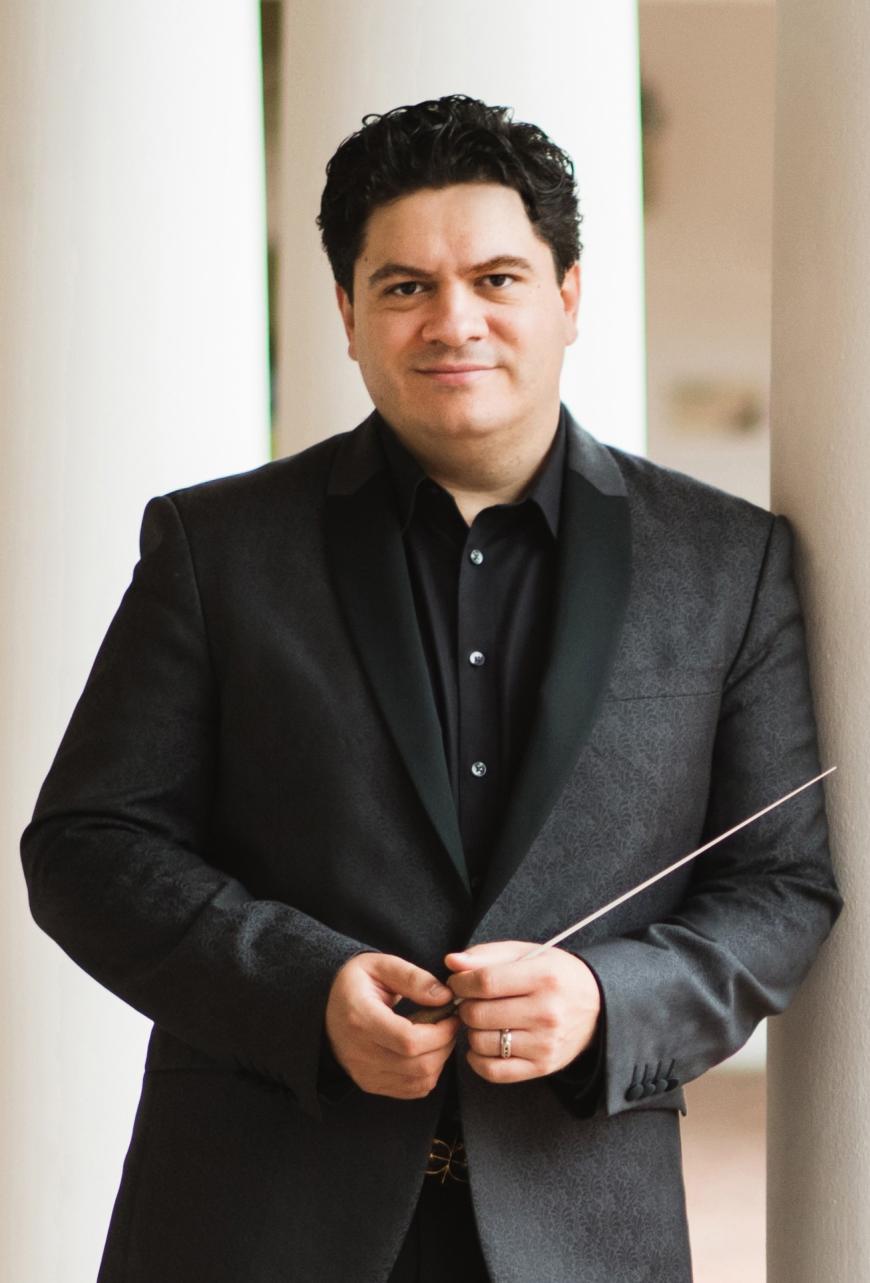
Music Director Cristian Măcelaru was on hand for his traditional opening-night interview, ever the articulate quipster as he recalled staying up all night trying to convince Wynton Marsalis that he was right about the fine points of the trumpeter’s Violin Concerto. You could sense that Măcelaru would be a hit with this new-music constituency from the moment he made his first appearance back in 2017 — and indeed, he has been, maintaining the festival’s mission while adding some dynamic personal flair of his own. As usual, almost all the composers were on hand to introduce their pieces, each in his or her own articulate, informative style.
One thing I did not see was any mention of the preliminary design options and renderings for a badly needed renovation of the hall. According to a festival source, city commitment and funding were never secured, and the pandemic and advances with the Golden State Warriors’ arena undercut progress on the Civic Auditorium project. And so the dry acoustics, the steep rake of the upper deck, and the lack of handrails on the stairs remain as reminders that this valuable festival deserves a safer, more modern home. Yet there is something to be said for the feeling of unity between the performers and the audience in this space, with the flat orchestra platform on the same level as the front row of folding chairs. We’re all in this progressive cultural world together, in other words.
This summer, the theme is “Rhythm and Sound,” with works catering to the percussion section that helped save the day in 2022. That promised to get the old hall rocking, even though Măcelaru felt driven to stick up for classical decorum, saying, “If you feel moved to move to the rhythms, please refrain.” It wasn’t always easy to comply.
Sarah Kirkland Snider’s Forward Into Light (2020) — the first of four pieces Friday night, all West Coast premieres — began with the faintest of flute flurries giving way to lyrical modules making their glittery points in a tonal language. Though this is not a minimalist work, the winds and brass frequently simulate digital delay effects, with notes and phrases echoing away into silence.
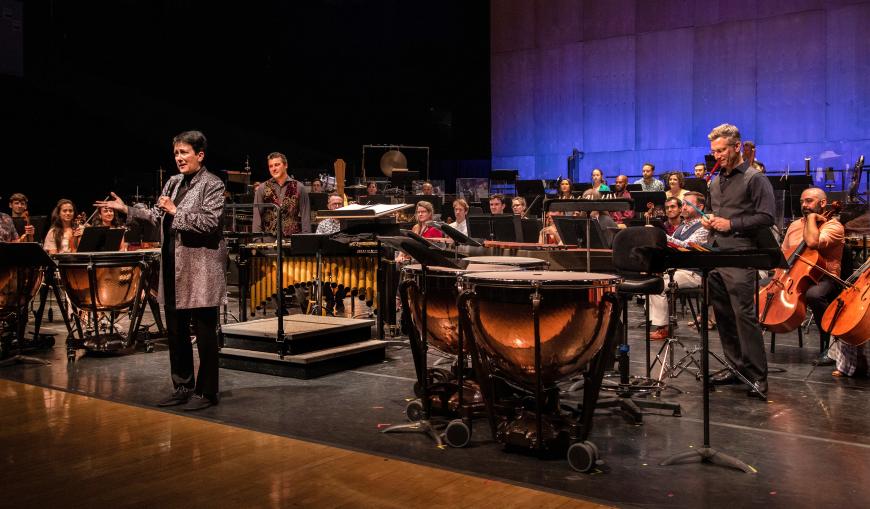
Live-wire raconteur Jennifer Higdon, whose works have been frequently performed at Cabrillo from Marin Alsop’s tenure onward, then introduced her Duo Duel (2020), which she started writing three and a half weeks before the pandemic shutdown. It’s really a concerto for double percussion in a single movement, with Svet Stoyanov and Matthew Strauss moving back and forth among a marimba, glockenspiel, vibraphone, and two sets of three timpani, often playing in unison. Higdon playfully said that there were 42,000 notes for the percussionists, having counted them herself.
Some lovely writing for violins and harp sets an agreeable tone at the beginning of the piece, but matters get rougher and more intricate, with the Cabrillo Festival Orchestra gamely hanging on to the increasing complexity. Higdon advertised one of the cadenzas as “the fastest cadenza ever written for percussionists” — and it turned out to be the last one, at the 17-minute mark, which has streaks of absolute wildness on marimba and vibes. By this time, the piece has turned into a manic scherzo racing all the way home.
Even though Duo Duel seems less like a duel and more like a unified assault by the two soloists on the rest of the orchestra, it’s a lot of jagged fun in which everyone wins. A recording of the piece with the co-commissioning Houston Symphony is coming out on Naxos this month.
Beethoven seems to be the favorite composer to be sliced, diced, and transformed by today’s note scribblers — just ask John Adams (Absolute Jest, Second String Quartet, Roll Over Beethoven), Tan Dun (Internet Symphony No. 1 [“Eroica”]), Caroline Shaw (Watermark), and now Sebastian Currier with Track 8 (2019), among many others. Currier’s launching pad is Beethoven’s Symphony No. 8, and the piece gets on that subject right away in its first movement, as Currier’s quiet, gauzy modernisms slam hard against fragmented bursts of Beethoven’s first movement for full orchestra. Each of the succeeding movements, played fast and with scarcely a pause by Măcelaru and crew, takes on its corresponding movement in the Beethoven, although one can hardly hear the influence in the third part.
In the finale, Beethoven and Currier are thoroughly integrated — at last, you can hear wisps of Beethoven’s third movement as well — storming on until the piece just slips away into the void. Likewise, the close of Bora Yoon’s brief The Wind of Two Koreas (2019) paraphrases the finale of Igor Stravinsky’s Firebird Suite, though its main business is a juxtaposition of Korean folk songs, South Korean K-pop, and North Korean patriotic anthems.
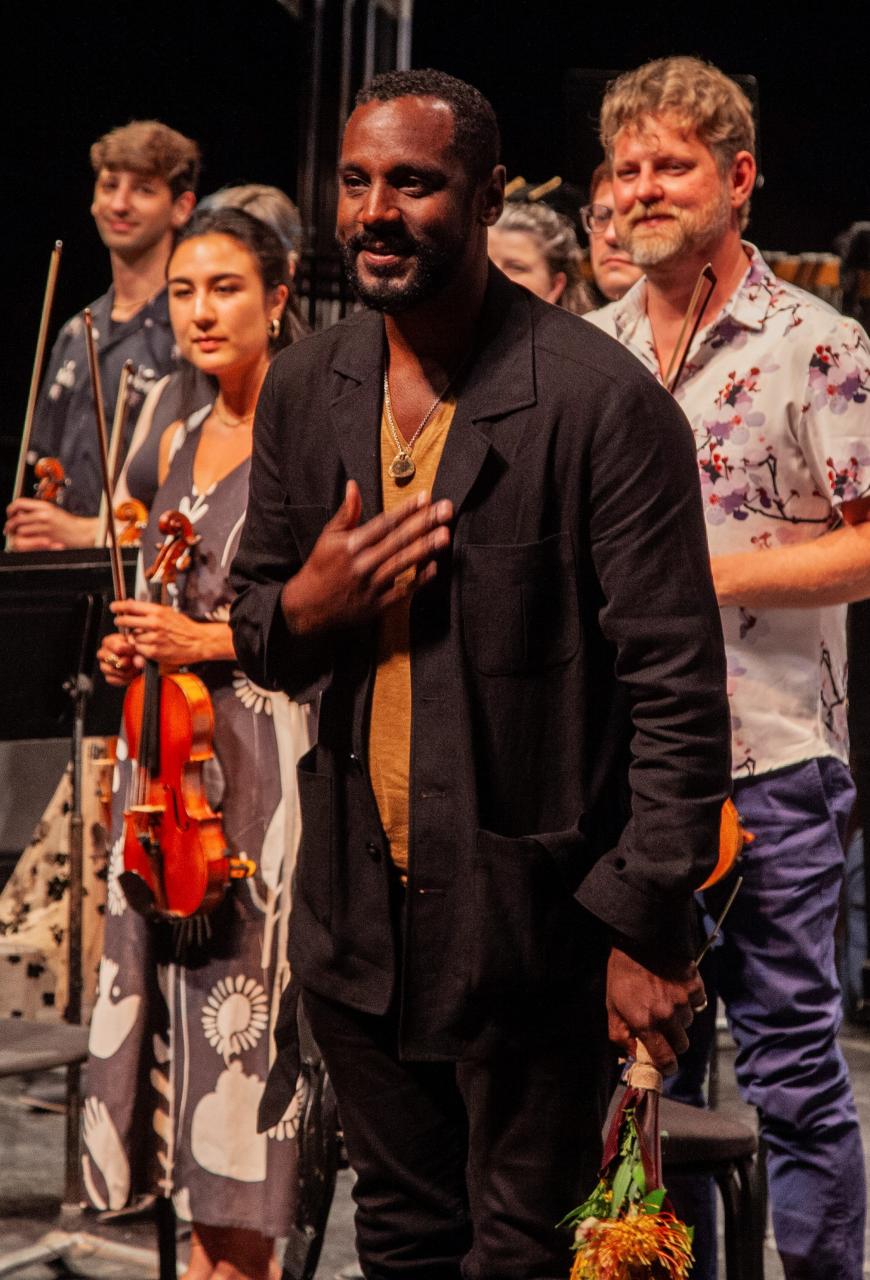
By contrast, there was only one West Coast premiere on the agenda Saturday night (Aug. 5), a major work by Carlos Simon, Tales – A Folklore Symphony (2021). Here, Simon adds to the legacy of recently revived symphonies by Black composers that use and transform folk music from the African American diaspora (among them William Grant Still’s Afro-American Symphony and William Levi Dawson’s Negro Folk Symphony). Whole movements are centered around the spirituals “Steal Away” and “Go Down Moses (Let My People Go)” and one of the many versions of the work song “John Henry,” as well as an Afrofuturist tale, “Motherboxx Connection” (a motherboxx being “a living computer with a heightened awareness of racial and sexual discourses surrounding the Black body”).
The futuristic tale comes first, with a colorful series of back-and-forth runs between the strings and brass — frequent antagonists throughout the work — that makes for a rousing prelude. Fantasy creeps into the warm orchestral embrace of mid-20th-century Americana in the “Flying Africans” movement (the one that uses “Steal Away”), where the percussionists wave flaps that evoke wings. For the “Go Down Moses” movement, machine-like strings and brass proclamations compete for attention again until a big climax, after which things come to a deathly quiet chill. You don’t have to guess that the finale is the “John Henry” movement, in which the metronomic beat of the steel-driving percussionists sets the pace as everything comes to a crashing, pounding conclusion. It’s a tremendously vital work, the best one that I’ve heard from this composer so far.
The other major work on the program dated from 2012 — almost a golden oldie by Cabrillo’s standards — Tan Dun’s dynamic percussion concerto The Tears of Nature. Each of the work’s three movements has a theme tied to a natural disaster — the Sichuan earthquake of 2008, the 2011 tsunami in Japan that triggered the Fukushima nuclear disaster, and 2012’s Hurricane Sandy, which devastated New York City and the New Jersey shore. Tan Dun seems to imagine that rain, rivers, and oceans are nature’s tears expressing regret at what it has done, and that the resilient human spirit carries on — quite a different tack from the condemnation of humankind’s destructive effect upon nature that one would expect nowadays.
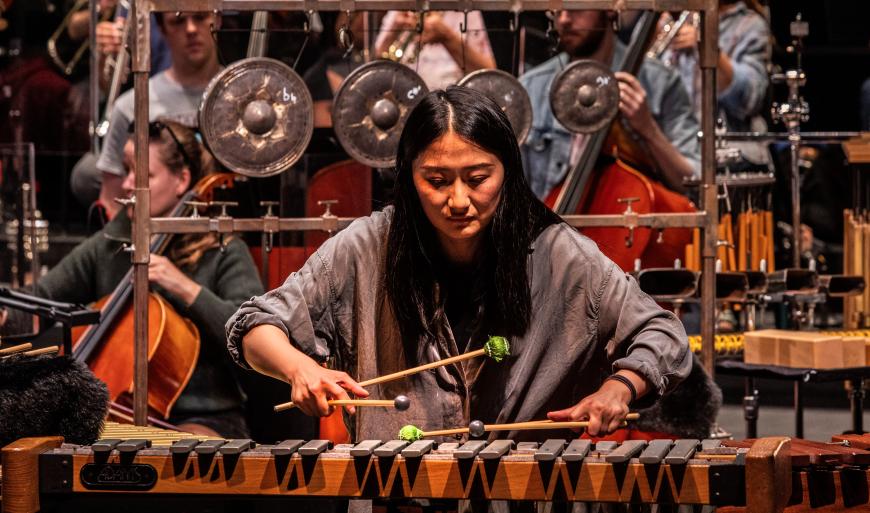
It’s an often violent piece — per nature’s furies — with taiko drums, timpani, and a conga pounding away in the first movement (the earthquake) and the crack of a whip launching the percussive mayhem in the third (the hurricane). The tsunami middle movement, by contrast, is rather spare and peaceful, sounding ancient and timeless at the same time, undergirded by a wheezy, barely audible drone created by four percussionists bowing on metal objects.
Yet ultimately, everything focuses upon the soloist. On Saturday, it was the endlessly agile Beibei Wang, whose quiet tapping of rocks to start the piece soon gave way to a one-woman percussion festival in front of and behind the orchestra. It all culminated in a long third-movement cadenza within an elliptical-shaped array of tom-toms, gongs, marimba, glockenspiel, and other hardware. With hair flying and fleet movements of foot, Wang put on a show that ultimately could not be confined to her instruments, for she tapped on the scaffolding, the floor outside the ellipse, and even on the metal railings supporting Măcelaru’s podium. The soloist is supposed to represent “nature and the human spirit dancing together” in this cadenza, after which the orchestra piles on with a short, wild, noisy coda that gradually slows down. Tan Dun, who wasn’t present for the performance, has used Wang frequently in the past, and it’s not hard to see why.
So far, so good. We’ll see if the good luck extends to the second Cabrillo weekend.
Correction: As originally published, this article noted that the 2020 season was lost to the pandemic. In fact, it was presented online.


